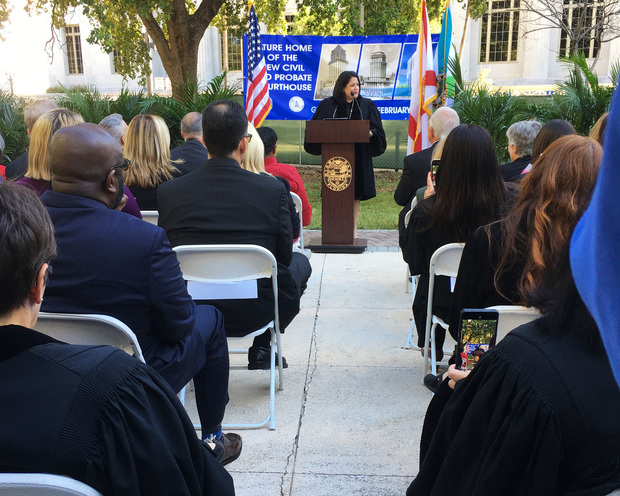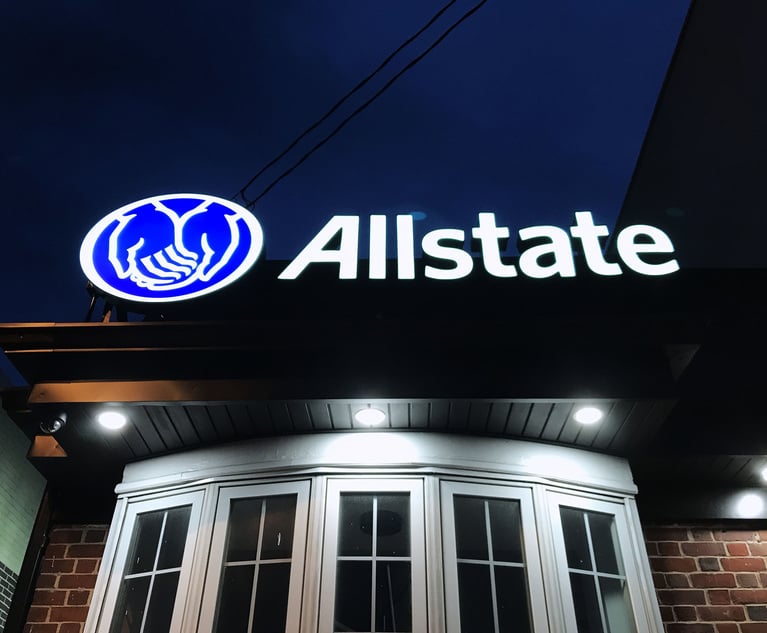'Amazonian Warriors' Lead Groundbreaking for Miami-Dade Civil Courthouse
Miami-Dade Circuit Chief Judge Bertila Soto and Judge Jennifer Bailey, the civil administrative judge, led the judicial campaign for new quarters.
February 03, 2020 at 12:54 PM
3 minute read
 Miami-Dade Circuit Chief Judge Bertila Soto at the February 2, 2020, courthouse groundbreaking. Photo: Cathy Wilson/ALM
Miami-Dade Circuit Chief Judge Bertila Soto at the February 2, 2020, courthouse groundbreaking. Photo: Cathy Wilson/ALM
Builder approval in hand, Miami-Dade County and court officials broke ground Monday on a new civil courthouse to replace a historic but physically ailing structure.
Miami-Dade Circuit Chief Judge Bertila Soto told the crowd of judges and dignitaries, "If I danced well, I'd be doing the happy dance."
A 23-story courthouse is due for completion in 2024 on a half-acre across the street from the aging Miami-Dade County Courthouse, which has been in service at 73 W. Flagler St. since 1928. The groundbreaking for a smaller version at the same location was 116 years ago, and the idea was for a building that would last 50 years.
Miami-Dade Clerk of Courts Harvey Ruvin, whose employees work in the old structure, noted, "Over the years, the warts have begun to show." Managers have dealt with basement flooding, asbestos contamination, mold, rain and plumbing leaks, often at the same time.
A public-private partnership led by the county and Plenary Justice Miami LLC agreed in December to build a 640,000-square-foot building with 46 courtrooms, a grand jury suite and a jury assembly room for the 300,000 people summoned for jury duty each year.
Circuit Judge Jennifer Bailey, the civil administrative judge who serves as the operations manager for the old courthouse, called it "a day that has been 35 years coming" based on the timing of a recommendation for a replacement.
She and Soto became what Bailey called "Amazonian warriors" to push the project. Left unspoken but aggravating to project boosters was the construction of modern courthouses in the neighboring Broward and Palm Beach circuits.
A failed courthouse referendum in 2014 revved up Miami's legal community, and Eugene Stearns of Stearns Weaver Miller Weissler Alhadeff & Sitterson galvanized attorneys to get something done.
"I was annoying for a lot of years," he conceded. "We're gathered here to celebrate success for sure."
Stearns commended All Aboard Florida and the Nichols, Brosch, Wurst, Wolfe & Associates architectural firm for conceptualizing a courthouse that "put a face on what could be here." The companies were in the running for the project but lost to Plenary.
The old structure will be positioned for sale in a way that protects its historical and architectural elements.
Overall, the county is expected to pay $852 million for the project over three decades, including $810 million divided into annual installments going to Plenary, which is responsible for construction, operations and maintenance.
County Commissioner Sally Heyman, who was credited with pushing the project through, said the old courthouse was "an edifice that was built in the days of the Model T." She looks forward to "an edifice our founders could not have begun to imagine."
This content has been archived. It is available through our partners, LexisNexis® and Bloomberg Law.
To view this content, please continue to their sites.
Not a Lexis Subscriber?
Subscribe Now
Not a Bloomberg Law Subscriber?
Subscribe Now
NOT FOR REPRINT
© 2025 ALM Global, LLC, All Rights Reserved. Request academic re-use from www.copyright.com. All other uses, submit a request to [email protected]. For more information visit Asset & Logo Licensing.
You Might Like
View All

Read the Document: DOJ Releases Ex-Special Counsel's Report Explaining Trump Prosecutions
3 minute read
US Judge OKs Partial Release of Ex-Special Counsel's Final Report in Election Case
3 minute read
Special Counsel Jack Smith Prepares Final Report as Trump Opposes Its Release
4 minute readLaw Firms Mentioned
Trending Stories
- 1South Florida Attorney Charged With Aggravated Battery After Incident in Prime Rib Line
- 2'A Death Sentence for TikTok'?: Litigators and Experts Weigh Impact of Potential Ban on Creators and Data Privacy
- 3Bribery Case Against Former Lt. Gov. Brian Benjamin Is Dropped
- 4‘Extremely Disturbing’: AI Firms Face Class Action by ‘Taskers’ Exposed to Traumatic Content
- 5State Appeals Court Revives BraunHagey Lawsuit Alleging $4.2M Unlawful Wire to China
Who Got The Work
J. Brugh Lower of Gibbons has entered an appearance for industrial equipment supplier Devco Corporation in a pending trademark infringement lawsuit. The suit, accusing the defendant of selling knock-off Graco products, was filed Dec. 18 in New Jersey District Court by Rivkin Radler on behalf of Graco Inc. and Graco Minnesota. The case, assigned to U.S. District Judge Zahid N. Quraishi, is 3:24-cv-11294, Graco Inc. et al v. Devco Corporation.
Who Got The Work
Rebecca Maller-Stein and Kent A. Yalowitz of Arnold & Porter Kaye Scholer have entered their appearances for Hanaco Venture Capital and its executives, Lior Prosor and David Frankel, in a pending securities lawsuit. The action, filed on Dec. 24 in New York Southern District Court by Zell, Aron & Co. on behalf of Goldeneye Advisors, accuses the defendants of negligently and fraudulently managing the plaintiff's $1 million investment. The case, assigned to U.S. District Judge Vernon S. Broderick, is 1:24-cv-09918, Goldeneye Advisors, LLC v. Hanaco Venture Capital, Ltd. et al.
Who Got The Work
Attorneys from A&O Shearman has stepped in as defense counsel for Toronto-Dominion Bank and other defendants in a pending securities class action. The suit, filed Dec. 11 in New York Southern District Court by Bleichmar Fonti & Auld, accuses the defendants of concealing the bank's 'pervasive' deficiencies in regards to its compliance with the Bank Secrecy Act and the quality of its anti-money laundering controls. The case, assigned to U.S. District Judge Arun Subramanian, is 1:24-cv-09445, Gonzalez v. The Toronto-Dominion Bank et al.
Who Got The Work
Crown Castle International, a Pennsylvania company providing shared communications infrastructure, has turned to Luke D. Wolf of Gordon Rees Scully Mansukhani to fend off a pending breach-of-contract lawsuit. The court action, filed Nov. 25 in Michigan Eastern District Court by Hooper Hathaway PC on behalf of The Town Residences LLC, accuses Crown Castle of failing to transfer approximately $30,000 in utility payments from T-Mobile in breach of a roof-top lease and assignment agreement. The case, assigned to U.S. District Judge Susan K. Declercq, is 2:24-cv-13131, The Town Residences LLC v. T-Mobile US, Inc. et al.
Who Got The Work
Wilfred P. Coronato and Daniel M. Schwartz of McCarter & English have stepped in as defense counsel to Electrolux Home Products Inc. in a pending product liability lawsuit. The court action, filed Nov. 26 in New York Eastern District Court by Poulos Lopiccolo PC and Nagel Rice LLP on behalf of David Stern, alleges that the defendant's refrigerators’ drawers and shelving repeatedly break and fall apart within months after purchase. The case, assigned to U.S. District Judge Joan M. Azrack, is 2:24-cv-08204, Stern v. Electrolux Home Products, Inc.
Featured Firms
Law Offices of Gary Martin Hays & Associates, P.C.
(470) 294-1674
Law Offices of Mark E. Salomone
(857) 444-6468
Smith & Hassler
(713) 739-1250






